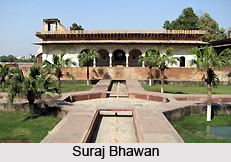 Deeg, a historical city of gardens and palaces, is located at thirty five km north of Bharatpur. The latitudinal and longitudinal extent of Deeg is 27° 25` and 77° 15` respectively. Both in terms of history and beauty this city is of great importance as it narrates the saga of the dominion and subsequent development of aesthetic outlook of the Jats. The beautification of Deeg was done by the great Jat rulers, Badan Singh and his son Suraj Mai.
Deeg, a historical city of gardens and palaces, is located at thirty five km north of Bharatpur. The latitudinal and longitudinal extent of Deeg is 27° 25` and 77° 15` respectively. Both in terms of history and beauty this city is of great importance as it narrates the saga of the dominion and subsequent development of aesthetic outlook of the Jats. The beautification of Deeg was done by the great Jat rulers, Badan Singh and his son Suraj Mai.
Places of Interest in Deeg
The historical city of Deeg is a traveler"s delight. The strong citadel with towering walls and bastions, almost in the heart of the town is the main tourist"s attraction of Deeg. The fort was constructed in the year 1730 by Suraj Mai, one of the rulers of Bharatpur. This formidable edifice has twelve towers and the largest of the towers is known as Lakha Burj. There is a partially ruined Palace inside the fort which has been re constructed in the20th century. Other tourist attractions inside the citadel are the tomb of Muhammad Shafi, a Mughal Mir bakshi, and the chhattri of Sultan Singh, one of the brothers of Suraj Mai.
The Palace or the Bhawans of Deeg are a major crowd puller. It was constructed by the ruler of Bharatpur, Suraj Mai. The Bhawans are planned with an ornamental garden along the edges of a vast rectangle guarded by two grand reservoirs, Roop Sagar and Gopal Sagar on the east and west respectively. The Bhawans are named as Gopal Bhawan, Hardev Bhawan, Keshav Bhawan, Kishan Bhawan, Nand Bhawan and Suraj Bhawan. Also referred to as the fountain Palace, these Bhawans are noted for their architectural elegance and perfection of workmanship.
The gardens of Deeg are an integral part of tourism in Deeg. The layout of the Deeg gardens is based on the strict formality of the Mughal horticultural plan known as charbagh or the four squared garden-pattern. The Jats architect left no stone unturned to enhance the spectacle of the gardens. Artificial charms of water are produced by the use of fountains and cascades. The fountains, about two thousand in number, are both of large and small sizes, closely interlinked with each other.

The Purana Mahal, built by Badan Singh, the Jat ruler, is a remarkable monument of Deeg. The importance of this structure lies in the treatment of architecture and paintings. The influence of Rajput architecture is prominent in this building. The Singh Pol, the Shish Mahal and the government museum are among the other places of tourist interest.
Visiting Information on Deeg
How to Reach:
Deeg is 132 km from Delhi and 95 km from Agra and is situated on the main Delhi-Mathura-Agra highway.
By Air: The nearest airport to Deeg is Agra.
By Rail: Bharatpur is the nearest railway station of Deeg from where trains are available to Delhi, Mumbai and Jaipur. One can also reach this town in Bharatpur district from Mathura by availing the railway services.
By Road: Deeg is an easy day trip from Bharatpur, Agra and Delhi. From both Alwar and Bharatpur buses regularly ply for Deeg. In case one wants to commute directly to Agra from Deeg, there is a bus for that too.
For accommodation it is best to stay in Bharatpur that has many lodging options including luxurious heritage hotels and moderate budget motels. There is also provision for dak bungalows and forest guest house.
The best time to visit Deeg is from October to February.
The small city of Deeg promises to be a tourist"s rendezvous because of its forts, magnificent palaces, spectacular gardens and rich history.



















